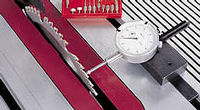|
Shop Notes
• Table Alignment
Click HERE for a printable version.
To start the video at a
specific step, click on the numbers in the left-hand column. |
|
1 |
When
ripping or crosscutting, the grooves in the table must be perpendicular to
the axis of the saw blade's rotation and the fence must be parallel to the
grooves. |
|
2 |
Everything depends on this
-
miter gauges, sliding tables, sleds and many other jigs either follow
these grooves or ride along the fence. If the fence or the grooves -- or
both -- is out of alignment, the cuts will be inaccurate. |
|
3 |
What happens if table
grooves or the fence is out of alignment? The wood rubs on the saw blade,
burning the wood and making the cut difficult. Sometimes, it will pull or
pinch the wood. If wood is burning every time you make a cuts, it's
time for some realignment. |
|
4 |
How far can the table
grooves or the fence be out of alignment before the wood starts to burn?
They can be off no more than the difference the thickness of blade
body subtracted from the thickness of teeth, and then divided by two.
Usually this is .015" to .025" over the diameter of the blade (10"). |
|
5 |
To check whether or not your saw is out of
alignment, start with the saw blade mounted. Remove the upper saw guard and
lower the table all the way. Mark a tooth (any tooth). Using the Dial
Set-Up Gauge (shown
right) mounted in one of the table grooves, measure the distance to the
tooth at the front or back of the blade. Rotate the blade 180 degrees and repeat. You can also
use the 5/32" Allen wrench and the miter gauge as a "feeler gauge" to make
this measurement, as shown in your Mark V Owner's Manual, but the dial gauge
is easier to use and more accurate.
IMPORTANT NOTE:
ALWAYS start by
unplugging Mark V. This is standard procedure when doing any maintenance,
but it's doubly important here since you will be working with the saw blade. |

Shopsmith Dial Set-Up Gauge #555884. |
|
6 |
Loosen all four table
mounting bolts with a 5/16" Allen wrench, then snug up the back right bolt
-- not tight, but snug.. |
|
7 |
Place a dollar bill
between the back trunnion and ribs of table tiebar. This serves as a shim -- a
dollar bill is about .005" thick. This is the clearance you need between the trunnions and the
tie bar to allow the parts to move freely. If you don't do this, the table may bind
after alignment when you try to tilt it. |
|
8 |
Barely snug up
table tilt lock -- just tight enough to hold the table horizontal. |
|
9 |
Lower table as far as it
will go and find the tooth you marked on the table saw blade. |
|
10 |
Rotate the saw blade so the marked tooth is close
to either the front or back of the table. Measure the distance from the
table groove to the tooth.
Rotate the blade 180 degrees and repeat. |
|
11 |
The measurements should
be with .005" of each other. If they are not, rotate the table to the right
or left -- it will pivot around the snug bolt -- until the measurements are
as close as you can make them. |
|
12 |
Snug up the two bolts on
the left side of the table. Tilt the table and snug up the front right bolt. All four bolts should be
snug. |
|
13 |
Go back and tighten all
four of the bolts in the same sequence. Loosen the table tilt lock and
remove the dollar bill. |
|
14 |
Check your results. |
|
© Copyright 2008
 Shopsmith,
Inc. Shopsmith,
Inc. |

 Shopsmith,
Inc.
Shopsmith,
Inc.